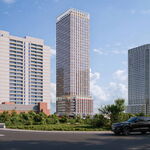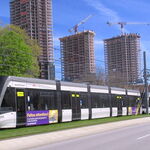D
Darren B
Guest
Adelaide would be mint for me personally, but I'm still of the opinion that Queen would better serve the city.
Adelaide is a great choice IMHO, I think they could design the stations to have access from King, and Queen, and new buildings (if there are ever any) could have direct access to the subway (as well as Queen).
What do you mean by "access"? Like they can get from one station to another without paying?
Access - like in the English word access - even though it might run on Adelaide, the stairs up to ground level would reach around Richmond - which would be the backside of any "office" building built on Queen. And no hip professional women would not get access free.....
Have a completely tunnelled LRT subway (similar to what is being proposed along Eglinton with the Transit City plan) that runs the complete DRL route (Dundas West, down to Queen, up to Pape). However, with that, run the section of the 501/502 that overlap the tunnel in the tunnel as well. The main issue with the Queen streetcars is the fact that they are running on a shared ROW, and thus cannot run at a service level that is efficient enough to effectively carry the ridership numbers. However, if you ran it in a tunnel, it could increase both speed and efficiency.
Another advantage of doing it as an LRT would be a direct connection to the current Don Mills LRT proposal. If they were using the same technology, etc, in essence they would become one line, as opposed to 2 separate lines requiring a transfer as would be the case if the DRL were built as a subway. I would also propose using the rail corridor adjacent to Dundas West station to be used to extend the LRT line northwestward from Dundas West up to Eglinton, in essence creating a second, wider YUS loop, servicing midtown and south of Bloor.
Exactly what Queen street needs. It's a bad idea to run a subway under a street like Queen with stops over a half km apart, when we can build LRT subways with stops that are 400m or less apart for much cheaper. That would complement Queen's vibrant nature much more. Why does it have to be HRT subway or bust?
Another advantage of doing it as an LRT would be a direct connection to the current Don Mills LRT proposal. If they were using the same technology, etc, in essence they would become one line, as opposed to 2 separate lines requiring a transfer as would be the case if the DRL were built as a subway. I would also propose using the rail corridor adjacent to Dundas West station to be used to extend the LRT line northwestward from Dundas West up to Eglinton, in essence creating a second, wider YUS loop, servicing midtown and south of Bloor.
In summary: if the subway option is chosen, I believe it should be along the rail/Wellington corridor (least disruption to existing subway/streetcar service during construction, greater capacity for intensification around the line).
Metrolinx has stated that the DRL is expected to divert 17,000 peak hour passengers away from the B-D subway, which is well within the capacity limits of an LRT. Even when you factor in transfers from the Dundas, College, Spadina, and Bathurst streetcars (Queen is purposely not included in that, because no line transfers would be required), it is still within the capacity limits of an LRT.
I'm not sure where you get 17,000 per hour as being well within the limits of LRT. I thought 10,000 per hour was the limit for LRT. The Yonge subway at the moment has a maximum capacity 25,000 per hour given the current signaling system and it is pretty much full. 17,000 would seem to be a rather healthy utilization for a subway.
I agree. LRT can be built for a fraction of the cost, would better serve the local population, and would still bring relief to the Bloor-Danforth subway.
Underground LRT lines are not a fraction of the cost of underground subway lines (unless you're considering, say, 4/5 a "fraction"), and there's no rule that says subway stations must be 1km apart while LRT stations must be 500m apart. For one thing, having twice as many stations on an underground LRT line would add quite a bit to the cost.
Well when you consider that the TTC is estimating that the Eglinton Crosstown LRT (arguably the closest comparison to an LRT DRL, LRT through a tunnel for the majority of the line) is projected to carry 159,000 people per day (or 58.2 million per year) in 2021, apparently it is within the limits of LRT.
And where did you get your stat for the Yonge line capacity? From everything I've read from the TTC, the current capacity of the Yonge line is 30,800 peak hour passengers. With the signal improvements, new rolling stock, etc, it will be upped to 48,000. But yes, you're right, the Yonge line is full, it's carrying 28,000 peak hour currently.
Underground LRT lines are not a fraction of the cost of underground subway lines (unless you're considering, say, 4/5 a "fraction"), and there's no rule that says subway stations must be 1km apart while LRT stations must be 500m apart. For one thing, having twice as many stations on an underground LRT line would add quite a bit to the cost.




